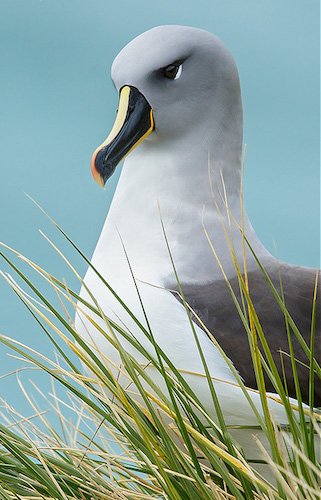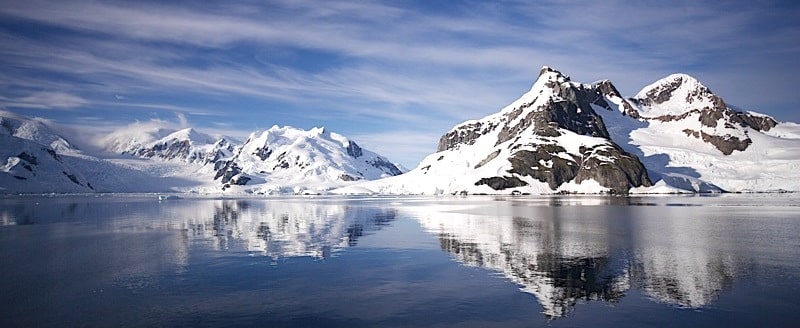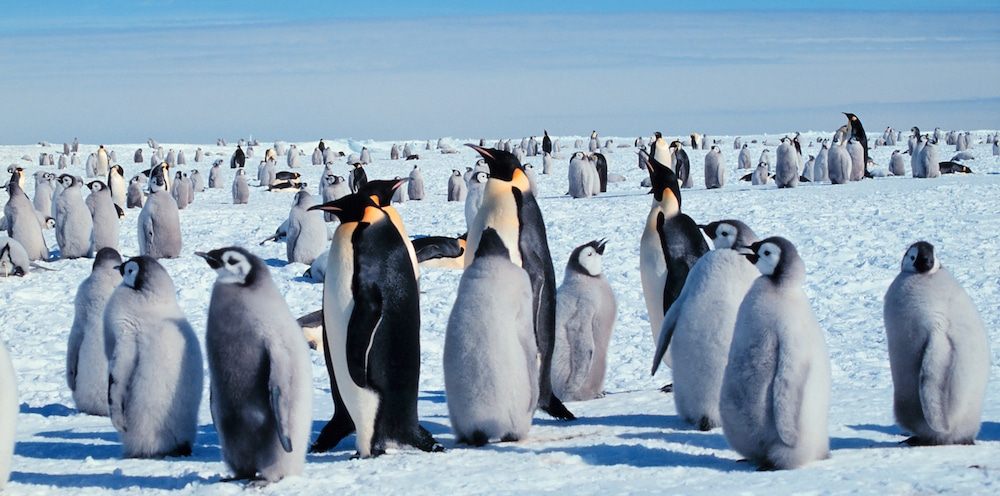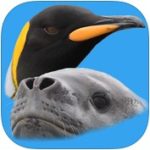Antarctica

Antarctica is Earth’s southernmost and least-populated continent. Situated almost entirely south of the Antarctic Circle and surrounded by the Southern Ocean (also known as the Antarctic Ocean), it contains the geographic South Pole. Antarctica is the fifth-largest continent, being about 40% larger than Europe, and twice the size of Australia having an area of 14,200,000 km2 (5,500,000 square miles). Its coastline is almost 18,000 km (11,200 mi) long. Most of Antarctica is covered by the Antarctic ice sheet, with an average thickness of 1.9 km (1.2 mi). There are numerous islands surrounding Antarctica, most of which are volcanic and very young by geological standards.
It is, on average, the coldest, driest, and windiest of the continents, and it has the highest average elevation. It is mainly a polar desert, with annual precipitation of over 200 mm (8 inches) along the coast and far less inland. About 70% of the world’s freshwater reserves are frozen in Antarctica, which, if melted, would raise global sea levels by almost 60 metres (200 ft). Antarctica holds the record for the lowest measured temperature on Earth, −89.2 °C (−128.6 °F). The coastal regions can reach temperatures over 10 °C (50 °F) in the summer. Native species of animals include mites, nematodes, penguins, seals and tardigrades. Where vegetation occurs, it is mostly in the form of lichen or moss.
Antarctica is governed by about 30 countries, all of which are parties of the 1959 Antarctic Treaty System. According to the terms of the treaty, military activity, mining, nuclear explosions, and nuclear waste disposal are all prohibited in Antarctica. Tourism, fishing and research are the main human activities in and around Antarctica. During the summer months, about 5,000 people reside at research stations, a figure that drops to around 1,000 in the winter. Despite the continent’s remoteness, human activity has a significant effect on it via pollution, ozone depletion, and climate change. Rivers exist in Antarctica; the longest is the Onyx.

©Christopher Michel CC BY 2.0 via Wikimedia Commons
The lakes that lie at the base of the continental ice sheet occur mainly in the McMurdo Dry Valleys or various oases. Lake Vostok, discovered beneath Russia’s Vostok Station, is the largest subglacial lake globally and one of the largest lakes in the world. It was once believed that the lake had been sealed off for millions of years, but scientists now estimate its water is replaced by the slow melting and freezing of ice caps every 13,000 years. During the summer, the ice at the edges of the lakes can melt, and liquid moats temporarily form. Antarctica has both saline and freshwater lakes.
The few terrestrial invertebrates are limited to the sub-Antarctic islands. The flightless midge Belgica antarctica, the largest purely terrestrial animal in Antarctica, reaches 6 mm (1⁄4 in) in size. Antarctic krill, which congregates in large schools, is the keystone species of the ecosystem of the Southern Ocean, being an important food organism for whales, seals, leopard seals, fur seals, squid, icefish, and many bird species, such as penguins and albatrosses. Antarctic sea life includes penguins, blue whales, orcas, colossal squids and fur seals.
Birding Antarctica
The bird life can be impressive and abundant in places and, of course, the penguins are a sight to behold. There are approximately 40 bird species that breed on or close to Antarctica, including species of petrels, penguins, cormorants, and gulls. Various other bird species visit the ocean around Antarctica, including some that normally reside in the Arctic. The emperor penguin is the only penguin that breeds during the winter in Antarctica; it and the Adélie penguin breed farther south than any other penguin.

King Penguins – ©Michael Van Woert, NOAA NESDIS, ORA, Public domain, via Wikimedia Commons
The two main gateways to the frozen continent are Ushuaia, Argentina and Christchurch, New Zealand. Ushuaia is the closest with a distance of 1000km from the Antarctic Peninsula. Due to its proximity and the wealth of animal life in the Peninsula, Ushuaia is Antarctica’s biggest tourist hub. Being in the Tierra del Fuego makes it a good spot for birders to start spotting.
A typical tourist voyage to the Antarctic Peninsula involves a ship voyage in the open sea from Ushuaia down the Beagle Channel and across the Drake Passage (2 days). This part of the voyage is lost to most visitors, but to birders it is a great opportunity to spot species like kelp gulls, terns, shearwaters, cormorants, petrels, prions, albatross (mainly Royal, Wandering, Black Browed and Grey Headed); fulmars etc.
Once in the Peninsula, one can get up close to several of these species particularly during landings to various islands or the continent itself. Penguins colonies are particularly popular with tourists allowing one to get to within 3 meters (IAATO rules) of the animals. The most commonly sighted species of bird sighted by tourists during landings are penguins (Adelie, Gentoo, Chinstrap, and sometimes Emperor, rockhopper and Macaroni); Sheathbills and Skua.
Other animals that one should look out for are seals (Leopard, Weddel, Crabeater etc); and whales (Fin, Humpback, Killer, Minke, Southern Right etc).

-
Number of bird species: 61
(As at May 2024)
Number of endemics: 2 Breeding Endemics
Emperor Penguin Aptenodytes forsteri
Antarctic Petrel Thalassoica antarctica
-
Avibase
PDF CheckllistThis checklist includes all bird species found in Antarctica , based on the best information available at this time. It is based on a wide variety of sources that I collated over many years. I am pleased to offer these checklists as a service to birdwatchers. If you find any error, please do not hesitate to report them. -
Wikipedia
Annotated ListThis is a list of the bird species recorded in Antarctica. The avifauna of Antarctica include a total of 62 species, of which 1 is endemic.
-
A Field Guide to the Wildlife of South Georgia
| Edited by Robert Burton & John Croxall | WILDGuides | 2012 | Paperback | 200 pages, 368 colour photos, 1 colour map | ISBN: 9780691156613 Buy this book from NHBS.com -
Birds of Patagonia, Tierra del Fuego and Antarctic Peninsula
| (The Falkland Islands and South Georgia) | By E Couve and C Vidal | Fantastico Sur | 2003 | Paperback | 656 pages, 200 colour photos, distrib maps | Out of Print | ISBN: 9789568007041 Buy this book from NHBS.com -
Birds of Southern South America and Antarctica
| By Martín R de la Peña, Maurice Rumboll, Gustavo Carrizo, Aldo A Chiappe, Luis Huber & Jorge R Rodriguez Mata | Princeton University Press | 2001 | Paperback | 304 pages, 97 plates with colour illustrations, 5 plates with b/w illustrations; b/w illustrations, 1000+ b/w distribution maps | Out of Print | ISBN: 9780691090351 Buy this book from NHBS.com

Antarctic Wildlife Guide app
Apple iOS | Android| mydigitalearth.com | 103.2 MB | Requires iOS 10.3 or later | Requires Android 4.0 and up | A guide to the birds, seals, dolphins and whales likely to be encountered on a voyage to the Antarctic Peninsula, The Falkland Islands and South Georgia. The area covered includes Ushuaia & Beagle Channel, the Drake Passage, the Antarctic Peninsula, the South Shetland Islands, South Orkney Islands, the Falkland Islands, and South Georgia.Organisations-
ASOC - Antarctic and Southern Ocean Coalition
WebsiteFounded in 1978, ASOC is the only non-governmental organisation working full time to preserve the Antarctic continent and its surrounding Southern Ocean. A coalition of over 30 NGOs interested in Antarctic environmental protection, ASOC represents the environmental community at Antarctic governance meetings and works to promote important Antarctic conservation goals. -
British Antarctic Survey
WebsiteOur Vision is to be a world-leading centre for polar science and polar operations, addressing issues of global importance and helping society adapt to a changing world. -
International Association of Antarctica Tour Operators (IAATO)
WebsiteA member organisation founded in 1991 to advocate and promote the practice of safe and environmentally responsible private-sector travel to the Antarctic.
Reserves-
Antarctic Specially Protected Area
InformationSatellite ViewAn Antarctic Specially Protected Area (ASPA) is an area on the continent of Antarctica, or on nearby islands, which is protected by scientists and several different international bodies. The protected areas were established in 1961 under the Antarctic Treaty System, which governs all the land and water south of 60 latitude and protects against human development. A permit is required for entry into any ASPA site. The ASPA sites are protected by the governments of Australia, New Zealand, United States, United Kingdom, Chile, France, Argentina, Poland, Russia, Norway, Japan, India, Italy, and Republic of Korea. There are 72 sites.
Guides & Tour Operators-
BirdQuest
Tour OperatorANTARCTICA, FALKLAND ISLANDS & SOUTH GEORGIA – The Nearest Thing to Birding Another World -
Birding Ecotours
Tour OperatorPlease contact us for details of Antarctic and Arctic birding cruises.Birding Ecotours aims to provide world-wide birding experiences of superb quality, while contributing to environmental conservation and disadvantaged communities. Please contact us for detailed information, queries and quotations as we are happy to help you in every aspect of planning your birding holiday. -
FieldGuides
Tour OperatorThe ultimate seabird and wildlife cruise, including fabulous South Georgia and the Falkland Islands. Variable fee depending on cabin choice. -
International Association of Antarctica Tour Operators (IAATO)
Tour OperatorIAATO is a member organization founded in 1991 to advocate, promote and practice safe and environmentally responsible private-sector travel to the Antarctic -
Naturalist Journeys
Tour OperatorDiscover the wilds of the Southern Hemisphere on an Antarctic cruise, from the Falkland Islands (Malvinas), to South Georgia Island, to the main continent of Antarctica, and witness stunning oceans, intensely blue ice, and prolific and unique wildlife. Although not for the faint of heart, cruising into the Antarctic is absolutely a trip of a lifetime. -
Oceanwide
Tour OperatorAntarctica Cruises with Birding Trips -
Quark Expeditions
Tour OperatorEndless activities spring to mind when one considers a voyage to Antarctica: observing penguins, whale-watching, photographing sculpted icebergs, stunning vistas of seldom-visited shorelines where few humans have ever set foot. -
Rockjumper
Tour OperatorSouth African company with a worldwide remit offering trips to Antarctica… -
Tropical Birding
Tour OperatorIf you are looking for the most extensive trip lists of birds and animals in the Antarctic this is the trip for you. This offers the very best sites in Antarctica, and is a must for both world listers chasing endemic birds, as well as photographers looking for the greatest wildlife spectacles in the Antarctic region. -
WildFoot
Tour OperatorLooking for a bird watching holiday? Look no further than our bird watching cruises.
Trip Reports-
2016 [12 December] - Dušan Brinkhuizen - The Falklands, South Georgia & Antarctica
PDF Report...Out of the crowds, we regularly picked out a “big boy”, the spectacular Southern Royal Albatross, of which we saw at least twenty. Slender-billed Prions started to appear in small numbers during the course of the day, and we also got our first Cape Petrels and Great Shearwaters. .... -
2017 [12 December] - Chris Lotz
PDF ReportWhat an incredible journey of a lifetime! The scenery was unbelievably spectacular. The birds were wonderful and included seven penguin species, Snow Petrel, many albatrosses including the most majestic of all, Wandering Albatross, along with the sleek, beautiful Light-mantled Albatross, and some rare, localised terrestrial birds such as South Georgia Pipit and Cobb’s Wren, and then of course all the sought-after birds of southernmost South America (Tierra del Fuego) such as Magellanic Woodpecker and the tricky White-bellied Seedsnipe. -
2017 [12 December] - Holly Faithfull
PDF ReportRockjumper’s Classic Antarctica II adventure started in Ushuaia, the most southerly city in the world. Late afternoon we boarded the Akademik Ioffe, a Russian research vessel, and our wonderfully stable home for this adventure to the south. -
2018 [11 November] - Mike Watson
PDF ReportOn a windswept visit to the Southern Ocean and ultimately the white continent, Antarctica, we enjoyed some amazing wildlife spectacles in stunning surroundings. One of the main features of this tour is the opportunity for endless seabirding from the deck of MV Plancius and our highlights included Wandering, Southern and Northern Royal, Light-mantled (Sooty), Grey-headed and Blackbrowed Albatrosses. Other tubenoses included Southern and Northern Giant Petrels, Southern Fulmar, Antarctic, Cape, Snow, Blue, Atlantic, Soft-plumaged, White-headed and White-chinned Petrels as well as Antarctic and Slender-billed Prions and Sooty, Manx and Great Shearwaters. -
2019 [02 February] - Woody Wheeler
PDF ReportWe spent a few hours in the quaint town of Port Stanley, with its impressive museum and well-preserved historical buildings, all with a distinct British appearance. Along the town shore we saw our first penguin of the trip, a Magellanic Penguin, along with a Chilean Skua, Kelp Goose and a Black-crowned Night Heron. -
2020 [03 March] - hans Meltofte
PDF ReportNew Zealand – Auckland Islands – Campbell Island – Ross Sea – Amundsen Sea – Bellingshausen Sea – Peter I Island – Argentina – South Atlantic – Uruguay -
2022 [11 November] - Colin Reed
PDF ReportFalkland Islands – South Georgia – Weddell Peninsula – South Shetland Islands -
2022 [11 November] - John Carlson
PDF ReportWe all gathered outside the domestic terminal at Azezia Airport in Buenos Aires, Argentina prior to boarding our flight to Puerto Madryn. The temperature in Buenos Aires was rather cool and pleasant. In between our visits and getting acquainted, a few of us wandered around the airport and found a few birds including breeding Monk Parakeets, Cattle Tyrants, Saffron Finches, Fork-tailed Flycatchers and a few rather striking goldenbreasted subspecies of Green-barred Woodpecker that were feeding on ants in a wooded field at the edge of the airport... -
2023 [03 March] - Brian Minshull,
PDF ReportBirds seen on New Island were Upland Goose, Kelp Goose, Ruddy-headed Goose, Falkland Steamer Duck, Crested Duck, Brown Skua, Southern Rockhopper Penguin, Black-browed Albatross, Royal Albatross spp., Southern Giant Petrel, Magellanic Cormorant, Black-crowned Night Heron, Turkey Vulture, Variable Hawk, Striated Caracara, Blackish Cinclodes, Dark-faced Ground-Tyrant, Austral Thrush, Black-chinned Siskin and Long-tailed Meadowlark. -
2023 [12 December] - Holly Faithfull
PDF Report...Before dinner we started birding from the stern deck, and got to see Kelp and Dolphin Gulls, South American Tern and Chilean Skua, as well as increasing numbers of the stunning Blackbrowed Albatross, Southern Fulmar and Southern Giant Petrel... -
2023 [12 December] - Rob Jansen & Romy Jansen - Antarctica – South Georgia - Falklands
PDF ReportRight when we arrived in Ushuaia – known as a place with some of the most beautiful landscapes in the world – we went to the ugliest place around: the rubbish dump. We still hadn’t seen Whitethroated Caracara on our travels, and this uncommon species is known to associate easily with Chimango Caracara and Southern Crested Caracara at the dump. Unfortunately it was drizzling and most Caracaras we observed were resting in trees. We found only one subadult White-throated far away. The next day we returned without finding one, despite lots of activity. In the end we found both an adult and juvenile White-throated Caracara on the road along the coast (-54.81408, - 68.20373) where it associated with many individuals of the other two species.
Other Links-
Antarctic Birds
WebsiteSystematic List -
Antarctic Birds
Webpage"First you fall in love with Antarctica, and then it breaks your heart." — Kim Stanley Robinson, first line of his book Antarctica... -
Antarctica Wildlife
Website -
Snow Petrels Pagodroma nivea
WebpageSnow petrels are pure white birds with black beaks and eyes. They are the size of a pigeon and arguably the most beautiful of all the Antarctic birds…
Photographers & Artists-
Photographer - Glenn Bartley
GalleryWorld class photos from South Georgia
-
Fatbirder - linking birders worldwide... Wildlife Travellers see our sister site: WAND
Skip to content

